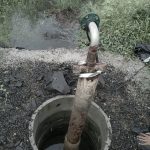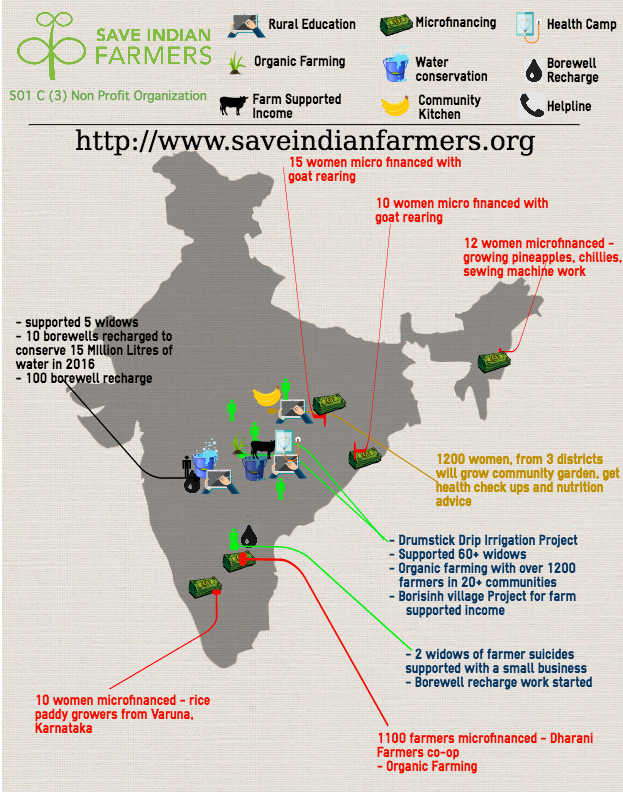A Case of Kaij and Ambajogai Tehsils in Beed District
The Problem
The residents of Kaij and Ambajogai tehsils of Beed district mainly depend on agriculture, dairy, goat rearing, local hens and manual labour for their livelihood. The majority of farming is rainfed, and farmers primarily grow kharif crops (soybean, tur, cotton, mung and urad). The irrigation sources are canals (nala) with irregular supply and water tanks. The main reasons for crop failure are insufficient rainfall and absence of water harvesting structures. This is felt most acutely in the summer season, when all the borewells run dry. The selected villages (Palaskheda in Kaij tehsil and Digholamba, Chanai and Ambajogai in Ambajogai tehsil) for this project also lacked drinking water (for livestock as well as humans) during summer.
The Solution
Since a majority of bore wells were getting dry before March, we wanted to recharge them using a reliable technique. This would elevate the water table, thereby improving availability of water for crops in rabi season and also for livestock in summer season. The resulting increase in the crop yield for beneficiaries will directly impact their income. Our project included recharging of bore wells in Palaskheda, Digholamba, Chanai and Ambajogai villages of Beed District.
Partners: Manavlok and Jnana Prabodhini
In Kaij and Ambajogai tehsil of Beed district, the borewell recharge project was financially supported by Save Indian Farmers (SIF) USA. From individual beneficiaries, Rs. 2000 was collected as a participant contribution. The on the ground organizations that implemented the project on are Manavlok (Ambajogai) and Jnana Prabodhini (Ambajogai).
Both Manavlok and Jnana Prabodhini have been working in the Marathwada region with commitment and vision to bring a smile on the poor farmer’s face. They have an experienced, dedicated and sensitive team that works on institution and capacity building of youth, farmers and women. They conduct regular awareness and training programs in these areas.
Objectives of the Project
1. Conserve water and increase water table
2. Minimize drinking water scarcity in summer
3. Enable farmers to take up rabi and summer crops
4. Mitigate the risk of crop failure due to water scarcity
Overview
The bore well recharge project was implemented on field under the guidance and leadership of Prasad Chikshe (Jnana Prabodhini) and Aniket Lohiya (Manavlok). The annual incomes of selected beneficiaries ranged between Rs 30,000 and Rs.80,000. The average depth of their bore wells was 200-300 feet. 9 bore well recharges were implemented by Jnana Prabodhini using Sankalpa Rural Development Society`s bore well recharge techniques, and 13 recharges were completed by Manavlok using slightly different techniques.
Bore well Recharge Technique
1. The first step is to mark out the recharge pit spot. The dimensions of the recharge pit around the bore well were 10ft x 10ft x 8ft.
2. Then a water storage pit of dimensions 18ft x 12ft x 6ft is marked 2 feet away from the recharge pit.
3. At the time of excavation of these pits, a 3-foot wide and 5-foot deep block is excavated between these pits in order to make the storage wall.
4. After excavation, the recharge pit is filled with stones up to 1.5 feet from the bottom.
5. Small holes are made on the casing pipe and the net is wiped with the help of coir rope around the casing.
6. Four cement rings are placed around the tube well covering the tube well all the way up to ground level.
7. Now the recharge pit is filled with stone, crashed stones, sand and again with crashed stones in that order up to ground level.
8. Finally, a concrete mixture is used to cover the boundaries of the recharge pit. This prevents rainwater from directly pouring into the recharge pit.
Field Visit
Save Indian Farmers`s representative Yashwantrao Yadav with officials from Manavlok and Jnana Prabodhini visited 9 bore well recharge sites in Kaij and Ambajogai tehsil on 15th September 2017. The purpose of the visit was to check on the present condition of the bore well recharge units and assess their impact.
Out of the 9 sites visited, 6 bore well recharges were executed by Manavlok and the other 3 by Jnana Prabodhini. All the 9 units were in good working condition. But 3 units needed some maintenance work. Although the quality of the bore well recharge work was good, it requires regular need-based maintenance and repair. The rainwater harvesting structures implemented by Manavlok were in better shape in comparison to the ones implemented by Jnana Prabodhini.
Maintenance / Repair Details
Some recharge pits are submerged in water. Drain the water to avoid the water logging. Remove the mud from the water storage pit to increase its water storage capacity.
Some water storage pits are partly filled with mud. This mud needs to be removed.
The boundaries of some recharge pits are broken. These need to be repaired to prevent rainwater from going directly into the recharge pit.
The issues observed during the site visit have been discussed with the farmers and the implementation partner for resolution. We are hoping to resolve all the issues after the monsoon subsides.
Impact of Project
- Positive feedback from bore well recharge beneficiaries.
- Earlier, bore wells were running up to the month of February. After implementing these water conservation techniques, they now run throughout the summer season.
- Previously, farmers were growing only kharif crops. After recharging their bore wells, the farmers now cultivate rabi crops (wheat, gram) as well.
- The bore well recharge system has also helped farmers alleviate the drinking water shortage in summer.
__________________________________________________________________________________________________________________________________
About the Author
Yashwantrao Yadav is a Doctoral Scholar from Tata Institute of Social Sciences (TISS), Mumbai working on Information Communication Technology (ICT) in Farming. On September 15, 2017, he visited Kaij and Ambajogai tehsils of Beed District to see the Rain Water Harvesting (RWR) interventions supported by Save Indian Farmers (SIF) and implemented through Manavlok and Jnana Prabodhini.
All Images by: Yashwantrao Yadav

























